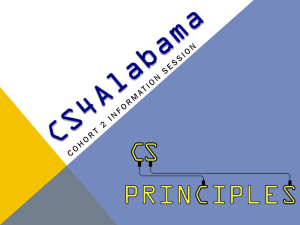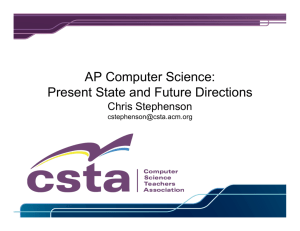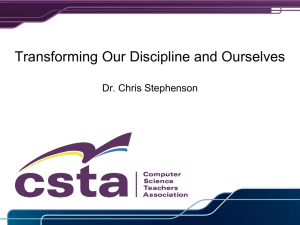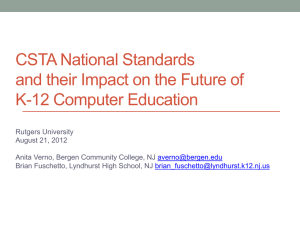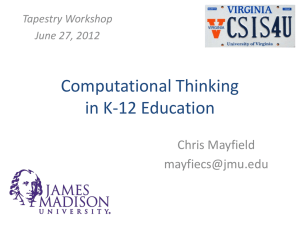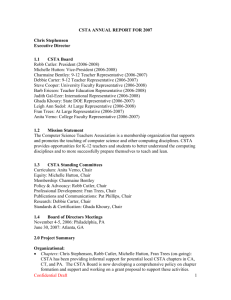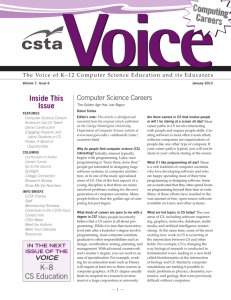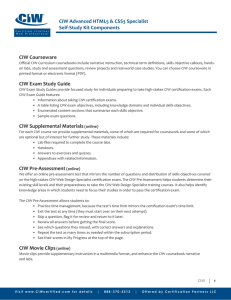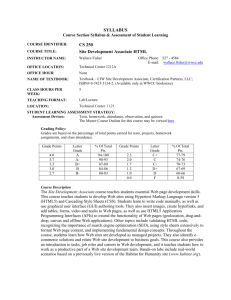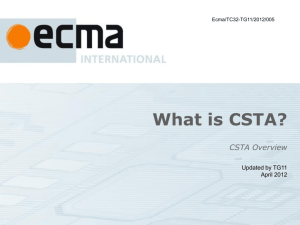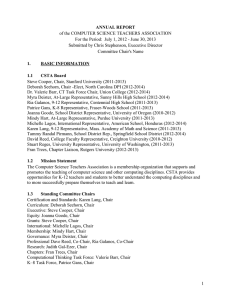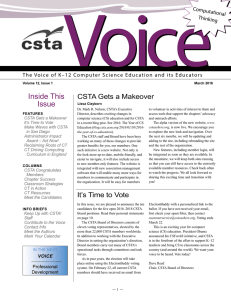CS_3B_Comoputer Science I
advertisement
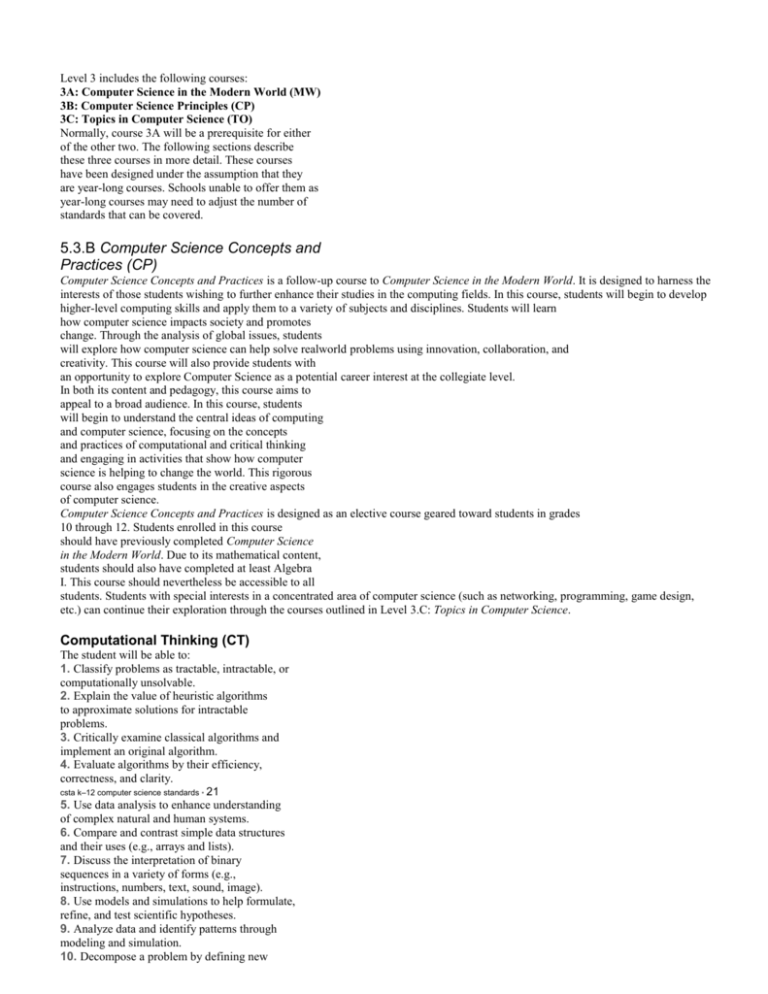
Level 3 includes the following courses: 3A: Computer Science in the Modern World (MW) 3B: Computer Science Principles (CP) 3C: Topics in Computer Science (TO) Normally, course 3A will be a prerequisite for either of the other two. The following sections describe these three courses in more detail. These courses have been designed under the assumption that they are year-long courses. Schools unable to offer them as year-long courses may need to adjust the number of standards that can be covered. 5.3.B Computer Science Concepts and Practices (CP) Computer Science Concepts and Practices is a follow-up course to Computer Science in the Modern World. It is designed to harness the interests of those students wishing to further enhance their studies in the computing fields. In this course, students will begin to develop higher-level computing skills and apply them to a variety of subjects and disciplines. Students will learn how computer science impacts society and promotes change. Through the analysis of global issues, students will explore how computer science can help solve realworld problems using innovation, collaboration, and creativity. This course will also provide students with an opportunity to explore Computer Science as a potential career interest at the collegiate level. In both its content and pedagogy, this course aims to appeal to a broad audience. In this course, students will begin to understand the central ideas of computing and computer science, focusing on the concepts and practices of computational and critical thinking and engaging in activities that show how computer science is helping to change the world. This rigorous course also engages students in the creative aspects of computer science. Computer Science Concepts and Practices is designed as an elective course geared toward students in grades 10 through 12. Students enrolled in this course should have previously completed Computer Science in the Modern World. Due to its mathematical content, students should also have completed at least Algebra I. This course should nevertheless be accessible to all students. Students with special interests in a concentrated area of computer science (such as networking, programming, game design, etc.) can continue their exploration through the courses outlined in Level 3.C: Topics in Computer Science. Computational Thinking (CT) The student will be able to: 1. Classify problems as tractable, intractable, or computationally unsolvable. 2. Explain the value of heuristic algorithms to approximate solutions for intractable problems. 3. Critically examine classical algorithms and implement an original algorithm. 4. Evaluate algorithms by their efficiency, correctness, and clarity. csta k–12 computer science standards • 21 5. Use data analysis to enhance understanding of complex natural and human systems. 6. Compare and contrast simple data structures and their uses (e.g., arrays and lists). 7. Discuss the interpretation of binary sequences in a variety of forms (e.g., instructions, numbers, text, sound, image). 8. Use models and simulations to help formulate, refine, and test scientific hypotheses. 9. Analyze data and identify patterns through modeling and simulation. 10. Decompose a problem by defining new functions and classes. 11. Demonstrate concurrency by separating processes into threads and dividing data into parallel streams. Collaboration (CL) The student will be able to: 1. Use project collaboration tools, version control systems, and Integrated Development Environments (IDEs) while working on a collaborative software project. 2. Demonstrate the software life cycle process by participating on a software project team. 3. Evaluate programs written by others for readability and usability. Computing Practice and Programming (CPP) The student will be able to: 1. Use advanced tools to create digital artifacts (e.g., web design, animation, video, multimedia). 2. Use tools of abstraction to decompose a large-scale computational problem (e.g., procedural abstraction, object-oriented design, functional design). 3. Classify programming languages based on their level and application domain 4. Explore principles of system design in scaling, efficiency, and security. 5. Deploy principles of security by implementing encryption and authentication strategies. 6. Anticipate future careers and the technologies that will exist. 7. Use data analysis to enhance understanding of complex natural and human systems. 8. Deploy various data collection techniques for different types of problems. Computers and Communications Devices (CD) The student will be able to: 1. Discuss the impact of modifications on the functionality of application programs. 2. Identify and describe hardware (e.g., physical layers, logic gates, chips, components). 3. Identify and select the most appropriate file format based on trade-offs (e.g., accuracy, speed, ease of manipulation). 4. Describe the issues that impact network functionality (e.g., latency, bandwidth, firewalls, server capability). 5. Explain the notion of intelligent behavior through computer modeling and robotics. Community, Global, and Ethical Impacts (CI) The student will be able to: 1. Demonstrate ethical use of modern communication media and devices. 2. Analyze the beneficial and harmful effects of computing innovations. 3. Summarize how financial markets, transactions, and predictions have been transformed by automation. 4. Summarize how computation has revolutionized the way people build real and virtual organizations and infrastructures. 5. Identify laws and regulations that impact the development and use of software. 6. Analyze the impact of government regulation on privacy and security. 22 • csta k–12 computer science standards 7. Differentiate among open source, freeware, and proprietary software licenses and their applicability to different types of software. 8. Relate issues of equity, access, and power to the distribution of computing resources in a global society. 5.3.C Topics in Computer Science (TO) At this level, interested and qualified students should be able to select one from among several electives to gain depth of understanding or special skills in particular areas of computer science. All of these electives will require the Level 3A course as a prerequisite, while some may require the Level 3B course as well. Most important, these courses provide students with an opportunity to explore topics of personal interest in greater depth, and thus prepare for the workplace or for further study at the postsecondary level. These electives include, but are not necessarily limited to: • Advanced Placement (AP) Computer Science A, • A projects-based course in which students cover a topic in depth, • A vendor-supplied course, which may be related to professional certification. These alternatives are discussed in more detail below. 5.3.C.1 AP Computer Science A The Advanced Placement Computer Science curriculum is well established (AP, 2010), and is offered at many secondary schools for students planning to continue their education in a two- or four-year college or university, possibly in computer science, business, or a related field. The AP Computer Science A course emphasizes problem solving and algorithm development, and introduces elementary data structures. Students who complete this course and score well on the exam may qualify for one-semester of college credit. Students taking the AP Computer Science A course should have completed Levels 1, 2, and 3A. That is, they need to be familiar with the computational/ algorithmic concepts introduced at those levels. The Level 3B course provides an excellent foundation in computer science principles and may also be useful for students intending to take the AP Computer Science A course. 5.3.C.2 Projects-Based Courses A projects-based course would be available to all students who have completed the Level 1 and Level 2 courses. Most project-based courses will also require completion of the Level 3A course. Some variants of this course would also require completion of the Level 3B course. A project-based course can be either a half-year or a full-year course. The projects in this kind of course will naturally reflect diverse student interests and specific faculty expertise. The specific projects that are chosen from year to year will also evolve to reflect the ever-changing characteristics of computer science and information technology. Ideally, each project should build upon basic computer science concepts and help students develop professional skills in the application of technology. Schools should also consider offering project-based courses in conjunction with a local college or university to ensure currency and tap outside expertise. While some of the project-based courses may be more skillsbased, they must still be tied to the “behind-the-scenes” activities of the software and other computer science principles in general. Making such connections enables students to problem solve when software does not perform as anticipated. Here are some project-based courses that could meet the requirements of a Level 3C course. Example: Desktop Publishing: This course introduces planning, page layout, and the use of templates to create flyers, documents, brochures, and newsletters. Word processing and graphical editing fluency (Level 2) will help ensure student success. Methods of distribution of these documents in both written and electronic formats should be included. This will necessitate understanding of Internet concepts and network connectivity (Level 3A). Example: Technical Communications: The ability to communicate and share ideas should be a core requirement for all high school graduates. This type of project focuses on end-user documentation and researching and presenting technical information to non-technical individuals in oral, written, and multimedia form. Fluency with word processing and presentation software and an understanding of computer science and technology (Level 3A) is required. Example: Multimedia: The use of multimedia has increased steadily at the user level, fueled by more efficient hardware and the availability of digital cameras and digital audio equipment. However, multimedia is often abused when incorporated into programs, webpages, and presentations. This project will provide instruction in the use of digital audio and video equipment and related editing software. A major focus will be deploying multimedia in a responsible fashion. Basic software skills (Level 2) and an understanding of multimedia concepts (Level 3A) are required. Example: Graphics: This class explores bitmap and vector-based graphics. The discussion includes benefits and limitations of each type of software and hands-on experience with both. CAD, CAM, and 3-D design software should be explored as well as bitmap software for creating and editing graphics. Availability of a digital camera and scanner is required. Responsible deployment of graphics including style and legal issues needs to be investigated. The discussion of vector-based graphics will be facilitated by completion of Level 3A—limits of computers and design for usability. Example: Game Programming: This course helps students understand the creativity needed to program effectively and reinforces the software development cycle. Students plan, design, code, and test computer games. Basic programming skills and an understanding of media (level 3B) are required. Example: Computational Modeling: This course explores the computational modeling of complex systems. Using agent-based techniques, locally relevant issues such as the spread of disease, ecosystems, and traffic patterns can be modeled and investigated and efforts to ameliorate negative impacts can be designed and tested virtually. In this course students will come to understand how interactions between individual elements (e.g., people, animals, or cars) and individuals and their environment can give rise to emergent, often unpredictable, patterns. Student project work includes abstracting a real-world issue or scenario, implementing a computational model by specifying the agents, interactions and environment in the model, and using automation to perform multiple runs of the simulation as an experimental testbed. Analysis of the model itself and the data it produces determine if and how the simulated world relates to the real world. Example: Web Development: At several places in the curriculum students are exposed to Internet concepts and HTML. This course includes Cascading Style Sheets (CSS) and presents a more in-depth view of the design and development issues that need to be considered for a multi-platform international implementation. The standardization of webpage development using the recommendations of the WWW Consortium is one focus issue. Webpage development will include coding HTML and CSS using a text editor and utilizing simple scripts to enhance webpages. Example: Web Programming: Students who have successfully completed Levels 3A and 3B but do not wish to take an AP course might nevertheless enjoy applying their programming skills to the WWW. To be successful, a solid understanding of Internet concepts, web development issues, and basic programming concepts will be required. Topics in this course can include client-side and server-side scripting languages. Students will need to write scripts and deploy them within webpages or on the web server. Example: Emerging Technologies: This project can include several distinct topics, and its content is expected to change on a regular basis. Curriculum and materials for this topic would need to be developed from current resources on the web, perhaps in conjunction with local colleges and universities, and with input from the professional sector of the Business Community. Example: Free and Open Source Software (FOSS) Development: Students who have successfully completed Level 3A may enroll in a course where they can contribute to an ongoing FOSS software project. Here, they might read code written by others, contribute suggestions for new features, identify bugs, write user documentation, and learn to use modern collaborative technologies. Students would actively participate in project discussion threads. Examples of FOSS projects that are accessible to students are identified at http://hfoss.org. Some other topics (along with their prerequisites) include: • The computer and animation (Level 3A) • Networking technologies (Level 3A) • Programming simulations (e.g., a computercontrolled chemistry experiment) (Levels 3A and 3B) • Object-oriented design and coding (Level 3B) • Effective use of computer applications (Levels 1 and 2) 5.3.C.3 Courses Leading to Industry Certification Such a course is primarily geared toward students planning on entering the workforce, continuing their education in a post-secondary technical school, or entering a two-year college Associates of Applied Science program. Students taking this course should have completed Levels 1 and 2, and typically the Level 3A courses. Industry certification provides a standard that is useful to potential employers in evaluating a candidate who has no prior work experience. Industry certifications are either vendor-neutral or vendor-sponsored. Vendor-sponsored curricula need to be evaluated carefully. While rich in content, some of these courses are structured to emphasize proprietary products rather than general concepts. Students who complete certification courses should be encouraged to take the corresponding exam as proof of acquired knowledge. Here are a few examples of vendor-neutral certification programs. Example: A+ Certified Technician: The CompTIA A+ certification is the industry standard for computer support technicians. The international, vendor-neutral certification proves competence in areas such as installation, preventative maintenance, networking, security and troubleshooting (http://www.comptia. org/certifications/listed/a.aspx). Two different exams are available: CompTIA A+ Essentials and CompTIA A+ Practical Application. The use of critical thinking skills to problem-solve is necessary to troubleshoot and resolve problems. These skills reinforce and extend the concepts presented in Levels 1, 2, and 3A. Example: Quick Security+: The field of computer security is one of the fastest-growing disciplines in Information Technology. CompTIA Security+ is an international, vendor-neutral certification that demonstrates competency in network security, threats and vulnerabilities, access control and identity management, cryptography, and more (http://certification. comptia.org/getCertified/certifications/security. aspx). These skills reinforce and extend the concepts presented in Levels 1, 2, and 3A. Example: Certified Internet Webmaster (CIW): CIW’s core curriculum focuses on the foundational standards of the web, including web design, web development and web security. CIW certifications verify that certified individuals have the skills to succeed in a technology-driven world (http://ciwcertified.com/ About_CIW/index.php). CIW curriculum is stateendorsed in various areas of the country (http://ciw certified.com/About_CIW/Why_CIW/highschools. csta k–12 computer science standards • 25 php). The CIW Web Foundations exam requires competency in Internet business, web design, and networking fundamentals. Many of these concepts are introduced in Levels 1, 2, and 3A. Find more detailed information about these and other certification programs, both vendor-specific and vendor-neutral, by searching the Web. 6. Implementation Challenges We understand that many obstacles lie in the way of arriving at an ideal model of K–12 computer science education for all students. How will room be found in the jam-packed curriculum? How will qualified teachers be recruited, trained, and credentialed? In the world of standards-centric evaluation of schools, should computer science support existing standards, or should new ones be designed for computer science? These and other questions and challenges are significant, but so are the benefits—to students and to society—of computer science becoming as much a part of a high-quality education as other core disciplines. Teaching any subject effectively depends on the existence of sound learning standards for students, explicit teacher certification standards; appropriate teacher training programs; effective curricular materials; and a core of teachers who are willing, able, and empowered to deliver the curriculum. K–12 computer science education faces unique challenges along all of these lines. The challenge of improving computer science education is significant and will require attention and interventions from multiple institutions. Professional organizations in computer science can make an important contribution. CSTA, for example, is a professional organization that supports and promotes the teaching of computer science and other computing disciplines. CSTA provides a large number of programs that include the development and dissemination of learning resources, the provision of professional development, and advocacy for state and federal level policies to improve computer science education. Other organizations such as ACM, the IEEE Computer Society, institutions of higher education, and national and local teacher organizations can also work to address these issues in K–12 computer science education. Industry is also deeply affected by pipeline issues and the scarcity of workers who have the skills to support and build the technology tools of the future. It is therefore in their best interest to contribute significantly to improving access to the quality of computer science courses at the K–12 level. For schools to widely implement these standards, work is needed in three important areas: teacher preparation, state-level content standards, and curriculum materials development. In addition, persons in leadership positions must acknowledge the importance of computer science education for the future of our society. States and accrediting organizations should make this a factor in their overall school accreditation process. Some states have begun to establish computer science content standards, define models for teacher certification, provide in-service training in computer science, and experiment with developing new curricular materials. However, a much wider effort and commitment are now required. Recently, efforts have increased to develop national and state content standards for computer science. Curriculum standards serve to define the skills and knowledge of the discipline to be acquired by every student. Content standards for computer science education within states must be developed and adopted in a way that parallels what has occurred in disciplines such as science, mathematics, and language arts. Curriculum content that is aligned with these standards can then be developed for the classroom. In the design of state standards, it is important to ensure the distinction between the teaching of IT skills and the teaching of computer science itself. That is, computer science must be viewed as a distinct subject area and technology should be viewed as a tool that cuts across all subject areas. Existing technology 26 • csta k–12 computer science standards standards, where present, should not be substituted for computer science standards. (For a comprehensive discussion of the ways in which states have failed to incorporate computer science standards into state standards in this way, see Running on Empty: The Failure to Teach K–12 Computer Science in the Digital Age at http://csta.acm.org/Communications/sub/ Documents.html. 7. Call to Action Computer science is a mainstream discipline that can no longer be ignored by public schools in the 21st century. The learning standards detailed in this document provide a basis by which states, schools of education, and individual school districts can begin to implement a coherent computer science curriculum that is available to all students. Much work needs to be done to translate these standards into teaching and laboratory materials that are pedagogically robust and culturally meaningful for all students. We hope state and federal departments of education, corporations, foundations, and other external stakeholders will support this work by providing appropriate incentives that will enable such a massive curriculum development effort to succeed. K–12 Standards Scaffolding Charts Collaboration csta k–12 computer science standards • 55 Computational Thinking 56 • csta k–12 computer science standards csta k–12 computer science standards • 57 Computing Practice and Programming 58 • csta k–12 computer science standards csta k–12 computer science standards • 59 Computers and Communications Devices 60 • csta k–12 computer science standards csta k–12 computer science standards • 61 Community, Global, and Ethical Impacts 62 • csta k–12 computer science standards
